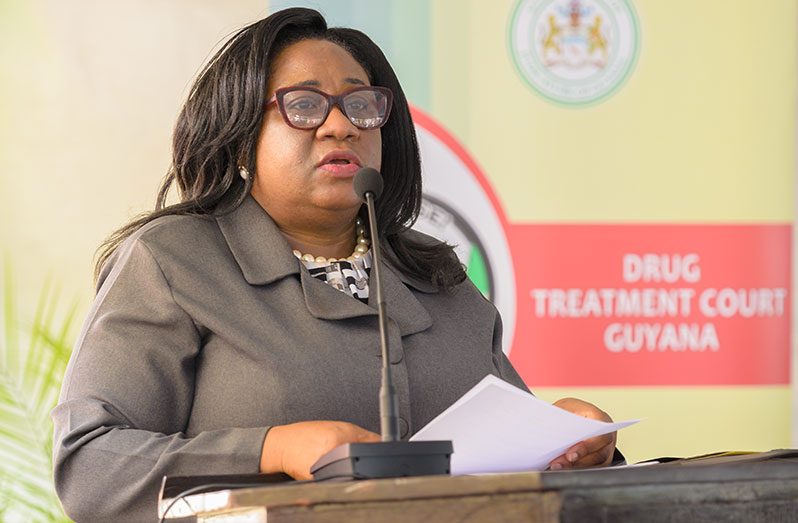-to give young offenders a second chance
THE Supreme Court of Judicature, on Tuesday, launched 12 Juvenile Drug Treatment Courts (DTC) in magisterial districts around the country as part of its efforts to reduce crime and substance use by adolescents, through the use of therapeutic interventions and judicial supervision.
The programme is being done in collaboration with the United Nations Children’s Fund (UNICEF) and the Organisation of American States Inter-American Drug Abuse Control Commission (OAS.CICAD.)
The formal ceremony was held at the Georgetown Magistrates’ Court, which houses one of the courts that are the first of its kind to be opened in Guyana.
The others are located at the magistrate’s courts at Suddie and Charity in Region Two; Wales, Leonora and Vreed-en-Hoop in Region Three; Vigilance and Sparendaam in Region Four; Fort Wellington in Region Five; Whim and New Amsterdam in Region Six; and Linden in Region Ten.

The programme adds to the adult pilot project for reforming drug offenders, which showed that participants, upon completion, were significantly less likely to be repeat offenders, compared to those sentenced with traditional punishments.
During the launch, Chief Magistrate Ann McLennan stressed that the programme gives young offenders a choice beyond traditional court proceedings to help them get the treatment needed to overcome their addiction and be productive people in society.
“The Juvenile Drug Treatment Court is a specialised court that will target persons who are youths under the age of 18…These will be youths who are charged with a minor non-violent criminal offence,” she told the gathering.

For cases involving drug possession, the quantity of narcotics must be less than 14 grams.
“The goal of the court is to provide a treatment option for young persons with substance use disorder, who may have committed minor offences to support their substance use, and to reduce minor offences committed by young persons with substance use disorders. The mission of the court is to reduce crime and substance use by youths through therapeutic interventions and judicial supervision,” she added.
McLennan explained that juveniles who meet the eligibility requirements must have pleaded guilty to the related charge(s).
The offenders’ sentences would then be deferred while they participate in the DTC programme.

“To enter the treatment court the participant is required to submit to an assessment, which would include a drug test on the controlled conditions within 24 hours of expressing a desire to be a part of that court,” she said.
The treatment plan has four stages consisting of a minimum of 10 months, which can go all the way to a maximum of 12 and is supervised by a competent and dynamic” team.
The Chief Magistrate later disclosed that the team comprises magistrates, state counsel from the Director of Public Prosecutions chambers, defence counsel, police officers, probation and social services officers, drug or substance abuse treatment providers, the case manager, representatives from the Ministry of Education, family members, and other selected personnel.
“The goal of this team is to provide a juvenile in conflict with the law with the option to enter a treatment programme that fosters abstinence as an alternative to an institutional penalty,” she said.
According to the Chief Magistrate, the team’s responsibility is to assess the participant to determine eligibility for the programme. The team members will also work together to formulate a treatment plan to supervise the youth participant throughout the programme, until graduation.
The treatment plan includes mandatory drug testing, court supervision, family involvement and community support.
“Throughout the programme, participants are rewarded for virtue and sanctions for noncompliance. After completion of the programme, a report is sent by the team to the originating court, which may impose a probationary period, issue a warning or even order a complete discharge of the offence for which the participant was charged,” she said.
She added: “The Juvenile Drug Treatment Court will continue to make a difference in the lives of our young people by providing support and enhanced treatment even after graduation,” McLennan said.
ALL HANDS-ON-DECK
Meanwhile, Chancellor of the Judiciary (ag), Justice Yonette Cummings-Edwards, in her remarks, disclosed that there has been a total of 625 cases of juveniles in conflict with the law over the years from 2019 to 2021.
This data was provided by the Guyana Police Force, in conjunction with the Director of Public Prosecutions (DPP).
“Over the years from 2019, if we look at the summary offences, we have 138 males and 59 females engaged in matters of a summary nature; on the indictable side, we have 83 males and 63 females, a total of 343 cases,” she disclosed.
According to the Chancellor, for the year 2020, 26 males and 8 females were charged for indictable offences, while 82 males and 50 females were charged for summary matters – a total of 166 cases.
However, she added that for 2021, only 21 males and one female were charged for indictable offences, while 51 males and 43 females were arraigned for summary offences bringing that year’s total to 116 cases.
“The important factor garnered from the stats is that the numbers seem to be dropping, and we wish for it to drop even more… We hope that with a rolling out of the drug treatment court and the services provided, the statistics will paint a brighter picture in terms of our youth involvement, or conflict with the law,” the Chancellor said.
She explained that an “all hands-on deck” approach is required for the success of the juvenile justice court.
“When a child comes into conflict with the law, early identification, screening and treatment of the underlying issues that cause the offending conflict are important. This provides an opportunity for us to treat the issue, the offending conduct, and the needs of the child,” the Chancellor said.
She added: “And in this court, there will be no human rights breach or administrators’ breach, as participation is voluntary and participants are given a chance to be heard to express their views on their behaviour, any disagreement on the fact and other relevant matters.”
She reminded the gathering of the famous proverb, “It takes a village to raise a child” before she explained that children’s safety and well-being should not be left to their own devices or to their parents alone, but should be a collaborative approach with the community and other bodies.
“The state has an important role to play in this regard. And the judiciary as an arm of the state must stand up to the task and play its part. Hence, we see the need for the Juvenile Drug Treatment Court, which will provide early intervention services,” she said.
To this end, she explained that, according to the statistic worldwide, there have been positive outcomes from having such courts.
“Today’s temperature and landscape do not require us to just lock up children, put them away in juvenile detention centres without having their substance use addressed. If we have locking up or incarceration as the only alternative available, it will not deal with the issue affecting our children,” she added.
According to the Chancellor, when juveniles are mixed with other hardcore offenders, and issues are not addressed, they become worse.
If left unaddressed, she added, children will come back into society and be of the view that society has failed them.
“They engage in behaviours mixed with hardcore assailants, commit more crimes and are thrown into adult prisons, and they graduate from penal institutions, sometimes with honours,” she said.
In concluding, she said that the Juvenile DTC represents a new paradigm which allows the court to practise and dispense comparative jurisprudence, and that which allows the intersection of law with reason, common sense logic, experience, compassion, empathy, and restorative justice.



.jpg)










